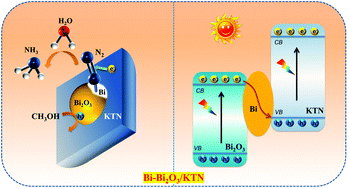A novel Z-scheme Bi-Bi2O3/KTa0.5Nb0.5O3 heterojunction for efficient photocatalytic conversion of N2 to NH3†
Abstract
A novel Z-scheme photocatalyst Bi-Bi2O3/KTa0.5Nb0.5O3 (KTN) composite was prepared by a simple solvothermal method. Compared with KTN, Bi/KTN, and Bi2O3/KTN, the Bi-Bi2O3/KTN ternary composite catalyst presented much better photocatalytic ammonia-synthesis efficiency. The optimum 3% Bi-Bi2O3/KTN composite exhibited an NH3 production rate of 466.2 μmol L−1 g−1 h−1, which was 7.5 times that of pure KTN. Characterization results indicated that the loaded Bi-Bi2O3 nanoparticles had an incomplete core–shell structure. The Bi metal acted as a bridge to intimately bind KTN and Bi2O3, contributing to the fast migration of electrons and improved charge separation through a Z-scheme mechanism. Thus, the highest separation efficiency of electron–hole pairs and photocatalytic activity were observed in the Bi-Bi2O3/KTN composite. Additionally, the exposed Bi metal can inhibit the hydrogen evolution reaction and promote the nitrogen reduction reaction, which may also contribute to the high photocatalytic activity of the ternary composite. This work is expected to unlock new ideas for the design of a new type of high-efficiency photocatalyst with Bi metal as an electron channel to improve the efficiency of photocatalytic ammonia synthesis.



 Please wait while we load your content...
Please wait while we load your content...